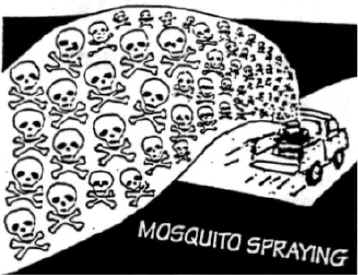 |
No Spray News James Irwin |
 |
No Spray News James Irwin |
April 15, 2002 Page 3
How "Perm"anent is "Perm"ethrin
Extonet and inchem.org both report that sprayed permethrin has a half-life of about a month in soils, and inchem lists a half- life on plant foliage of 10 days. I have not seen any discussion about whether permethrin stays put on plant foliage, or instead tends to find its way into the house via pets, shoes, and kids.Complicating matters further is the fact that permanone, the brand of permethrin to be used by the city of Columbia, is only 4% permethrin, and 96% other chemicals.
Richland County to Continue Spraying Malathion
Tammie Brewer of Richland County Vector Control told me on March 13 that Richland County has no plans to change insecticides. However, you may have noticed recently in The State that vector control was asking Richland County residents allergic to permethrin and resmethrin (another synthetic pyrethroid), as well as malathion, to contact vector control. How are you supposed to know if you are allergic to these two insecticides until you have been sprayed with them?
Is Permethrin any More Effective at Killing Mosquitoes?
Since mosquito spraying, per se, is widely regarded to be ineffective against the tiger mosquito (Aedes albopictus), simply changing insecticides cannot be expected to make any difference in controlling (or, more precisely, not controlling) Columbia's predominant mosquito.
As for the other species of mosquito that Columbia claims to be spraying for, Culex quinquefasciatus, here's what a spraying trial of permethrin (and malathion and resmethrin) concluded:
Evaluation of Aerial and
Ground-Applied Adulticides
Against Mosquito Species in Arkansas and Louisiana
R. L. Groves, J. C. McAllistar, C. L. Meek,
and M. V. Meisch
| Note: Only "submarginal control" was obtained, even though these trial used caged mosquitoes and open field conditions. | The experiments conducted with Cx.
quinquefasciatus, both aerially and ground, proved to challenge all compounds.
Although submar- ginal control was obtained, effective comparisons were achieved. The Culex
species in question likely represent one of the most insecticide-tolerant species in the
southern USA and most certainly in the Baton Rouge area. Journal of the American Mosquito Control Association, 10(3):407-412, 1994 |